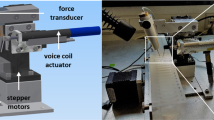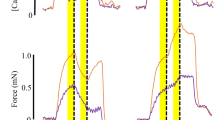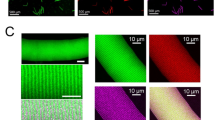Abstract
Mechanical dissection of single intact mammalian skeletal muscle fibers permits real-time measurement of intracellular properties and contractile function of living fibers. A major advantage of mechanical over enzymatic fiber dissociation is that single fibers can be isolated with their tendons remaining attached, which allows contractile forces (in the normal expected range of 300–450 kN/m2) to be measured during electrical stimulation. Furthermore, the sarcolemma of single fibers remains fully intact after mechanical dissection, and hence the living fibers can be studied with intact intracellular milieu and normal function and metabolic properties, as well as ionic control. Given that Ca2+ is the principal regulator of the contractile force, measurements of myoplasmic free [Ca2+] ([Ca2+]i) can be used to further delineate the intrinsic mechanisms underlying changes in skeletal muscle function. [Ca2+]i measurements are most commonly performed in intact single fibers using ratiometric fluorescent indicators such as indo-1 or fura-2. These Ca2+ indicators are introduced into the fiber by pressure injection or by using the membrane-permeable indo-1 AM, and [Ca2+]i is measured by calculating a ratio of the fluorescence at specific wavelengths emitted for the Ca2+-free and Ca2+-bound forms of the dye. We describe here the procedures for mechanical dissection, and for force and [Ca2+]i measurement in intact single fibers from mouse flexor digitorum brevis (FDB) muscle, which is the most commonly used muscle in studies using intact single fibers. This technique can also be used to isolate intact single fibers from various muscles and from various species. As an alternative to Ca2+ indicators, single fibers can also be loaded with fluorescent indicators to measure, for instance, reactive oxygen species, pH, and [Mg2+], or they can be injected with proteins to change functional properties. The entire protocol, from dissection to the start of an experiment on a single fiber, takes ∼3 h.
This is a preview of subscription content, access via your institution
Access options
Access Nature and 54 other Nature Portfolio journals
Get Nature+, our best-value online-access subscription
$29.99 / 30 days
cancel any time
Subscribe to this journal
Receive 12 print issues and online access
$259.00 per year
only $21.58 per issue
Buy this article
- Purchase on Springer Link
- Instant access to full article PDF
Prices may be subject to local taxes which are calculated during checkout






Similar content being viewed by others
References
Allen, D.G., Lamb, G.D. & Westerblad, H. Skeletal muscle fatigue: cellular mechanisms. Physiol. Rev. 88, 287–332 (2008).
Argiles, J.M., Busquets, S., Stemmler, B. & Lopez-Soriano, F.J. Cachexia and sarcopenia: mechanisms and potential targets for intervention. Curr. Opin. Pharmacol. 22, 100–106 (2015).
Hawley, J.A. Adaptations of skeletal muscle to prolonged, intense endurance training. Clin. Exp. Pharmacol. Physiol. 29, 218–222 (2002).
Häkkinen, K., Alen, M. & Komi, P.V. Changes in isometric force- and relaxation-time, electromyographic and muscle fibre characteristics of human skeletal muscle during strength training and detraining. Acta Physiol. Scand. 125, 573–585 (1985).
Duchateau, J. & Enoka, R.M. Human motor unit recordings: origins and insight into the integrated motor system. Brain Res. 1409, 42–61 (2011).
Barclay, C.J. Modelling diffusive O2 supply to isolated preparations of mammalian skeletal and cardiac muscle. J. Muscle Res. Cell Motil. 26, 225–235 (2005).
Zhang, S.J., Bruton, J.D., Katz, A. & Westerblad, H. Limited oxygen diffusion accelerates fatigue development in mouse skeletal muscle. J. Physiol. 572, 551–559 (2006).
Bruton, J., Tavi, P., Aydin, J., Westerblad, H. & Lännergren, J. Mitochondrial and myoplasmic [Ca2+] in single fibres from mouse limb muscles during repeated tetanic contractions. J. Physiol. 551, 179–190 (2003).
Gonzalez, E. & Delbono, O. Recovery from fatigue in fast and slow single intact skeletal muscle fibers from aging mouse. Muscle Nerve 24, 1219–1224 (2001).
Stary, C.M. & Hogan, M.C. Intracellular pH during sequential, fatiguing contractile periods in isolated single Xenopus skeletal muscle fibers. J. Appl. Physiol. 99, 308–312 (2005).
Olsson, K. et al. Intracellular Ca2+-handling differs markedly between intact human muscle fibers and myotubes. Skelet. Muscle 5, 26 (2015).
Llano-Diez, M. et al. Impaired Ca2+ release contributes to muscle weakness in a rat model of critical illness myopathy. Crit. Care 20, 254 (2016).
Allen, D.G., Lännergren, J. & Westerblad, H. Intracellular ATP measured with luciferin/luciferase in isolated single mouse skeletal muscle fibres. Pflügers Arch. 443, 836–842 (2002).
Dahlstedt, A.J., Katz, A., Tavi, P. & Westerblad, H. Creatine kinase injection restores contractile function in creatine-kinase-deficient mouse skeletal muscle fibres. J. Physiol. 547, 395–403 (2003).
Westerblad, H. & Allen, D.G. Myoplasmic free Mg2+ concentration during repetitive stimulation of single fibres from mouse skeletal muscle. J. Physiol. 453, 413–434 (1992).
Westerblad, H., Bruton, J.D. & Lännergren, J. The effect of intracellular pH on contractile function of intact, single fibres of mouse muscle declines with increasing temperature. J. Physiol. 500, 193–204 (1997).
Brown, D.E. & Sichel, F.J. The myogram of the isolated skeletal muscle cell. Science 72, 17–18 (1930).
Lännergren, J. & Westerblad, H. The temperature dependence of isometric contractions of single, intact fibres dissected from a mouse foot muscle. J. Physiol. 390, 285–293 (1987).
Westerblad, H. & Allen, D.G. Changes of myoplasmic calcium concentration during fatigue in single mouse muscle fibers. J. Gen. Physiol. 98, 615–635 (1991).
Westerblad, H. & Allen, D.G. Intracellular calibration of the calcium indicator indo-1 in isolated fibers of Xenopus muscle. Biophys. J. 71, 908–917 (1996).
Bruton, J.D., Cheng, A.J. & Westerblad, H. Methods to detect Ca2+ in living cells. Adv. Exp. Med. Biol. 740, 27–43 (2012).
Hernandez, A. et al. Dietary nitrate increases tetanic [Ca2+]i and contractile force in mouse fast-twitch muscle. J. Physiol. 590, 3575–3583 (2012).
Jimenez-Moreno, R., Wang, Z.M., Gerring, R.C. & Delbono, O. Sarcoplasmic reticulum Ca2+ release declines in muscle fibers from aging mice. Biophys. J. 94, 3178–3188 (2008).
Place, N. et al. Ryanodine receptor fragmentation and sarcoplasmic reticulum Ca2+ leak after one session of high-intensity interval exercise. Proc. Natl. Acad. Sci. USA 112, 15492–15497 (2015).
Yamada, T. et al. Nitrosative modifications of the Ca2+ release complex and actin underlie arthritis-induced muscle weakness. Ann. Rheum. Dis. 74, 1907–1914 (2015).
Baylor, S.M. & Hollingworth, S. Sarcoplasmic reticulum calcium release compared in slow-twitch and fast-twitch fibres of mouse muscle. J. Physiol. 551, 125–138 (2003).
Bakker, A.J., Cully, T.R., Wingate, C.D., Barclay, C.J. & Launikonis, B.S. Doublet stimulation increases Ca2+ binding to troponin C to ensure rapid force development in skeletal muscle. J. Gen. Physiol. 149, 323–334 (2017).
Andrade, F.H., Reid, M.B., Allen, D.G. & Westerblad, H. Effect of hydrogen peroxide and dithiothreitol on contractile function of single skeletal muscle fibres from the mouse. J. Physiol. 509, 565–575 (1998).
Bruton, J.D. et al. Reactive oxygen species and fatigue-induced prolonged low-frequency force depression in skeletal muscle fibres of rats, mice and SOD2 overexpressing mice. J. Physiol. 586, 175–184 (2008).
Cheng, A.J., Bruton, J.D., Lanner, J.T. & Westerblad, H. Antioxidant treatments do not improve force recovery after fatiguing stimulation of mouse skeletal muscle fibres. J. Physiol. 593, 457–472 (2015).
Moopanar, T.R. & Allen, D.G. The activity-induced reduction of myofibrillar Ca2+ sensitivity in mouse skeletal muscle is reversed by dithiothreitol. J. Physiol. 571, 191–200 (2006).
Moopanar, T.R. & Allen, D.G. Reactive oxygen species reduce myofibrillar Ca2+ sensitivity in fatiguing mouse skeletal muscle at 37 °C. J. Physiol. 564, 189–199 (2005).
Hwee, D.T. et al. The Ca2+ sensitizer CK-2066260 increases myofibrillar Ca2+ sensitivity and submaximal force selectively in fast skeletal muscle. J. Physiol. 595, 1657–1670 (2017).
Nocella, M., Cecchi, G., Bagni, M.A. & Colombini, B. Effect of temperature on crossbridge force changes during fatigue and recovery in intact mouse muscle fibers. PLoS One 8, e78918 (2013).
Nocella, M. et al. Force decline during fatigue is due to both a decrease in the force per individual cross-bridge and the number of cross-bridges. J. Physiol. 589, 3371–3381 (2011).
Yeung, E.W., Ballard, H.J., Bourreau, J.P. & Allen, D.G. Intracellular sodium in mammalian muscle fibers after eccentric contractions. J. Appl. Physiol. 94, 2475–2482 (2003).
Bruton, J., Jeffries, G.D. & Westerblad, H. Usage of a localised microflow device to show that mitochondrial networks are not extensive in skeletal muscle fibres. PLoS One 9, e108601 (2014).
Aydin, J. et al. Increased mitochondrial Ca2+ and decreased sarcoplasmic reticulum Ca2+ in mitochondrial myopathy. Hum. Mol. Genet. 18, 278–288 (2009).
Duty, S. & Allen, D. The distribution of intracellular calcium concentration in isolated single fibres of mouse skeletal muscle during fatiguing stimulation. Pflügers Arch. 427, 102–109 (1994).
Elzinga, G., Lännergren, J. & Stienen, G.J. Stable maintenance heat rate and contractile properties of different single muscle fibres from Xenopus laevis at 20 °C. J. Physiol. 393, 399–412 (1987).
Koga, S. et al. Increasing temperature speeds intracellular PO2 kinetics during contractions in single Xenopus skeletal muscle fibers. Am. J. Physiol. Regul. Integr. Comp. Physiol. 304, R59–R66 (2013).
Allen, D.G., Lännergren, J. & Westerblad, H. The use of caged adenine nucleotides and caged phosphate in intact skeletal muscle fibres of the mouse. Acta Physiol. Scand. 166, 341–347 (1999).
Cheng, A.J. et al. Reactive oxygen/nitrogen species and contractile function in skeletal muscle during fatigue and recovery. J. Physiol. 594, 5149–5160 (2016).
Michaelson, L., Shi, G., Ward, C. & Rodney, G. Mitochondrial redox potential during contraction in single intact muscle fibers. Muscle Nerve 42, 522–529 (2010).
Pal, R., Basu, T.P., Li, S., Minard, C. & Rodney, G. Real-time imaging of NADPH oxidase activity in living cells using a novel fluorescent protein reporter. PLoS One 8, e63989 (2013).
Murphy, R.M. & Lamb, G.D. Important considerations for protein analyses using antibody based techniques: down-sizing Western blotting up-sizes outcomes. J. Physiol. 591, 5823–5831 (2013).
Schiaffino, S. & Reggiani, C. Fiber types in mammalian skeletal muscles. Physiol. Rev. 91, 1447–1531 (2011).
Nielsen, J., Cheng, A.J., Ørtenblad, N. & Westerblad, H. Subcellular distribution of glycogen and decreased tetanic Ca2+ in fatigued single intact mouse muscle fibres. J. Physiol. 592, 2003–2012 (2014).
Chemello, F. et al. Microgenomic analysis in skeletal muscle: expression signatures of individual fast and slow myofibers. PLoS One 6, e16807 (2011).
Murgia, M. et al. Single muscle fiber proteomics reveals unexpected mitochondrial specialization. EMBO Rep. 16, 387–395 (2015).
Liu, Y., Carroll, S.L., Klein, M.G. & Schneider, M.F. Calcium transients and calcium homeostasis in adult mouse fast-twitch skeletal muscle fibers in culture. Am. J. Physiol. 272, C1919–1927 (1997).
Szent-Gyorgyi, A. Free-energy relations and contraction of actomyosin. Biol. Bull. 96, 140–161 (1949).
Wood, D.S., Zollman, J., Reuben, J.P. & Brandt, P.W. Human skeletal muscle: properties of the 'chemically skinned' fiber. Science 187, 1075–1076 (1975).
Larsson, L. & Salviati, G. A technique for studies of the contractile apparatus in single human muscle fibre segments obtained by percutaneous biopsy. Acta Physiol. Scand. 146, 485–495 (1992).
Natori, R. The property and contraction process of isolated myofibrils. Jikei Med. J. 1, 119–126 (1954).
Hellam, D.C. & Podolsky, R.J. Force measurements in skinned muscle fibres. J. Physiol. 200, 807–819 (1969).
Lamb, G.D. Excitation-contraction coupling and fatigue mechanisms in skeletal muscle: studies with mechanically skinned fibres. J. Muscle Res. Cell Motil. 23, 81–91 (2002).
Duke, A.M. & Steele, D.S. Interdependent effects of inorganic phosphate and creatine phosphate on sarcoplasmic reticulum Ca2+ regulation in mechanically skinned rat skeletal muscle. J. Physiol. 531, 729–742 (2001).
Lamboley, C.R. et al. Contractile properties and sarcoplasmic reticulum calcium content in type I and type II skeletal muscle fibres in active aged humans. J. Physiol. 593, 2499–2514 (2015).
Owen, V.J., Lamb, G.D., Stephenson, D.G. & Fryer, M.W. Relationship between depolarization-induced force responses and Ca2+ content in skeletal muscle fibres of rat and toad. J. Physiol. 498, 571–586 (1997).
Ørtenblad, N. & Stephenson, D.G. A novel signalling pathway originating in mitochondria modulates rat skeletal muscle membrane excitability. J. Physiol. 548, 139–145 (2003).
Posterino, G.S. & Lamb, G.D. Effect of sarcoplasmic reticulum Ca2+ content on action potential-induced Ca2+ release in rat skeletal muscle fibres. J. Physiol. 551, 219–237 (2003).
Godt, R.E. & Maughan, D.W. Swelling of skinned muscle fibers of the frog. Experimental observations. Biophys. J. 19, 103–116 (1977).
Curtin, N.A., Diack, R.A., West, T.G., Wilson, A.M. & Woledge, R.C. Skinned fibres produce the same power and force as intact fibre bundles from muscle of wild rabbits. J. Exp. Biol. 218, 2856–2863 (2015).
Baylor, S.M. & Hollingworth, S. Calcium indicators and calcium signalling in skeletal muscle fibres during excitation-contraction coupling. Prog. Biophys. Mol. Biol. 105, 162–179 (2011).
Zhao, M., Hollingworth, S. & Baylor, S.M. Properties of tri- and tetracarboxylate Ca2+ indicators in frog skeletal muscle fibers. Biophys. J. 70, 896–916 (1996).
Gineste, C. et al. Cyclophilin D, a target for counteracting skeletal muscle dysfunction in mitochondrial myopathy. Hum. Mol. Genet. 24, 6580–6587 (2015).
Lindqvist, J., Cheng, A.J., Renaud, G., Hardeman, E.C. & Ochala, J. Distinct underlying mechanisms of limb and respiratory muscle fiber weaknesses in nemaline myopathy. J. Neuropathol. Exp. Neurol. 72, 472–481 (2013).
Yeung, E.W., Head, S.I. & Allen, D.G. Gadolinium reduces short-term stretch-induced muscle damage in isolated mdx mouse muscle fibres. J. Physiol. 552, 449–458 (2003).
Bakker, A.J., Head, S.I., Williams, D.A. & Stephenson, D.G. Ca2+ levels in myotubes grown from the skeletal muscle of dystrophic (mdx) and normal mice. J. Physiol. 460, 1–13 (1993).
Acknowledgements
J. Lännergren (Karolinska Institutet) was essential in designing the dissection procedures and the custom-made equipment for dissection, stimulation, and force recording described in this protocol. This work was supported by a Swedish Research Council grant to H.W. and by Swedish Research Council for Sport Science grants to A.J.C. and H.W.
Author information
Authors and Affiliations
Contributions
A.J.C. performed the experiments and data collection. A.J.C. and H.W. were equally involved in drafting the manuscript.
Corresponding author
Ethics declarations
Competing interests
The authors declare no competing financial interests.
Integrated supplementary information
Supplementary Figure 1 Dissection trough schematic.
General dimensions of the dissection trough are shown in the illustration (red arrows). The muscle bundle is held by inserting the tendons into the split ends of the nylon rod located in the middle of the chamber (blue). The nylon rod is pulled into a tight-fitting stainless steel tube, thus closing the split end onto the tendon. A polyethylene tube is inserted into the frame to fit the stainless steel tube tightly into the acrylic frame to prevent leakage of Tyrode, while at the same time allowing rotation and longitudinal movements. Silicon grease can be added between the stainless steel tube and the tube insert to further prevent leakage of Tyrode. The shelf is useful for stabilizing the dissection tools during dissection, and it can also be used as a shelf to mount the dissected single fiber into T-clips. The glass bottom allows for darkfield illumination. Tyrode is typically filled to the top surface of the chamber.
Supplementary Figure 2 Stimulation pen.
General dimensions of a custom-made stimulation pen are shown in the illustration. Two common insulated multi-strand copper wires are inserted into the body of a ballpoint pen and are intertwined with the teflon-coated platinum wires. Note that it is not possible to solder copper wire to platinum wire using typical soldering metal. The teflon-coating on the platinum wire ends must be removed to conduct an electrical current. Epoxy is filled into the tip to prevent the wires from moving.
Supplementary information
Combo PDF
Supplementary Figures 1 and 2. (PDF 234 kb)
Single fiber dissection from the mouse FDB muscle.
This video describes how to dissect an intact single fiber starting from the whole isolated FDB muscle. (MP4 27001 kb)
Rights and permissions
About this article
Cite this article
Cheng, A., Westerblad, H. Mechanical isolation, and measurement of force and myoplasmic free [Ca2+] in fully intact single skeletal muscle fibers. Nat Protoc 12, 1763–1776 (2017). https://doi.org/10.1038/nprot.2017.056
Published:
Issue Date:
DOI: https://doi.org/10.1038/nprot.2017.056
This article is cited by
-
Ca2+ and force during dynamic contractions in mouse intact skeletal muscle fibers
Scientific Reports (2024)
-
The relationship between single muscle fibre and voluntary rate of force development in young and old males
European Journal of Applied Physiology (2023)
-
Loss of dysferlin or myoferlin results in differential defects in excitation–contraction coupling in mouse skeletal muscle
Scientific Reports (2021)
-
Calcium sensitivity during staircase with sequential incompletely fused contractions
Journal of Muscle Research and Cell Motility (2021)
-
LIM and cysteine-rich domains 1 (LMCD1) regulates skeletal muscle hypertrophy, calcium handling, and force
Skeletal Muscle (2019)
Comments
By submitting a comment you agree to abide by our Terms and Community Guidelines. If you find something abusive or that does not comply with our terms or guidelines please flag it as inappropriate.



